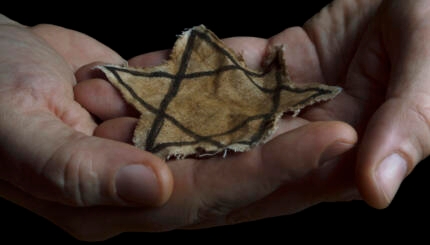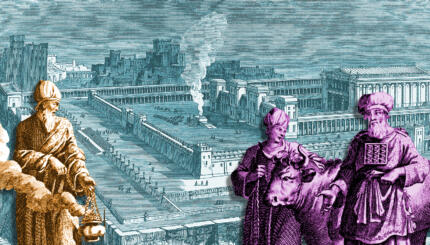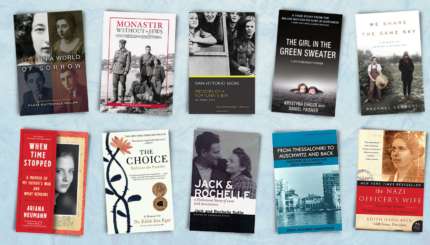The Holocaust poses new challenges for commemorative representations. How to remember the six million civilians murdered for who they were–and not for what was done to them? How to represent a tragedy that is characterized by absence, from the missing bodies to the destroyed gas chambers, the absence of names and archives? How to design a national Holocaust memorial in a country that participated in the deportation of Jews, or in a country that did not experience the Holocaust on its soil?
Among the countries that have a national Holocaust memorial, Israel, France, the United States, and Germany offer contrasting responses to Holocaust commemoration and representation.

Memorial at Yad Vashem
Israel
The first national Holocaust memorial was erected in Israel, the country that became home to the majority of Holocaust survivors. On August 19, 1953, the Knesset (Israeli parliament) passed the Yad Vashem Law, which established the authority to commemorate the six million Jews murdered by the Nazis; their destroyed communities; those who fought and struggled; and the Righteous among the Nations who risked their lives to save Jews.
Yad Vashem, located on Har Hazikaron (the Mount of Remembrance) in Jerusalem, first included a crypt with an eternal flame burning next to the names of major concentration camps. The original complex was also comprised of a sculpture garden, a museum, and an archive and research center. The permanent exhibition emphasized the role of Jewish heroes, martyrs, and survivors, in accordance with the early Zionist vision that honored the “new Jew” as a proud fighter rather than a helpless victim.

Help us keep Jewish knowledge accessible to millions of people around the world.
Your donation to My Jewish Learning fuels endless journeys of Jewish discovery. With your help, My Jewish Learning can continue to provide nonstop opportunities for learning, connection and growth.
In 2005, the memorial reopened after a ten-year renovation and expansion designed by Israeli architect Safdie, whose architecture itself carries meaning: the tilted walls forming a triangle represent the star of David, and visitors zigzag between dead-end rooms, artifacts that block hallways, and narrow spaces. The new historical museum is a multi-media exhibit about the Holocaust, ending with a breathtaking view of the Jerusalem hills–confirmation of the redemptive nature of the State of Israel after the Holocaust.
Until this impressive extension, Yad Vashem was viewed as a dusty, old-fashioned museum, and it attracted mostly Jewish visitors. The huge new complex has immediately become a major tourism destination for diverse groups of visitors. The powerful effect of the new Yad Vashem is precisely the combination of thoughtful architecture, solemn space, artworks, a didactic museum, and a center dedicated to research.
France
The Holocaust memorial of Paris was envisioned at the same time as Yad Vashem, but it was initiated by the Jewish community, not the French government. This reflects France’s ambiguous role and image during and after World War II. Over 76,000 Jews were deported from France with the zealous help of the Vichy government and police, but after the war, France presented itself as a model of resistance to the occupiers, and kept its distance from the Holocaust.
In 1961, France did sponsor a national monument to deportation, a crypt located by Notre-Dame Cathedral by the Seine River, that indiscriminately honors all victims of deportation.
The Jewish memorial, initiated by members of the Jewish resistance, was unveiled in Paris on October 30, 1956 in the presence of European political and religious leaders. Similar to Yad Vashem, it is a crypt with an eternal flame burning amidst names of concentration camps. A year later, France’s Chief Rabbi Jacob Kaplan solemnly deposited ashes from death camps and from the Warsaw ghetto in the crypt, changing the nature of the memorial to a holy place containing human remains. The main focus of the memorial is the archive and research center that was started during the war by members of the Jewish underground who tried to document the persecution of Jews as it unfolded.
In 2005, the French memorial underwent State-financed renovation and a monument was added to the site. Now, in the front patio, two white marble walls bear the alphabetically organized names of Holocaust victims deported from France. Visitors can touch the name of a relative, and leave yahrzeit (memorial) candles or flowers at the wall, an echo to Maya Lin’s Vietnam War Memorial in Washington, D.C.
The wall in Paris is powerful, reflecting the extent of the loss of Jewish lives in France, but it is also modest, and it can sometimes go unnoticed by visitors who rush to enter the main building. There is, however, a little room in the museum that acts as a more condensed and efficient memorial, displaying the Vichy Police files on Jews. This collection of thousands of index files, compiled between 1941 and 1944 to identify French Jews for deportation, is displayed behind a glass wall and is accessible to researchers. Though incomplete, the files represent an original and authentic memorial to the victims, in many ways stronger than newly built walls or multi-media exhibits.
The United States
Like Israel, the United States did not experience the Holocaust on its soil, but became home to a large number of Holocaust survivors and a significant Jewish community of European origin. In 1980, the U.S. Congress agreed to have a Holocaust memorial and museum built on the National Mall in Washington, D.C.
Funded by the government and inaugurated in 1994, the United States Holocaust Memorial Museum‘s prominent location among other national landmarks shows how the Holocaust is integrated in American history, and how the Jewish experience is part of the contemporary American landscape.
The architect of the museum, James Ingo Freed, introduced the concept of architecture as a “resonator of memory.” Some rooms remind visitors of barbed-wired camps or fenced ghettos; visitors feel a sense of oppression as the steel doors of the elevator contain them tight in almost no light; they take hallways that lead to dead-ends; they are crowded in narrow rooms. The architecture serves the content of the exhibition by leading visitors to experience a kind of malaise in their bodies, and not just learn about the Holocaust with their intellect.
The museum includes replicas of objects–a cattle wagon used for deportation, clothes of inmates, documents–that contribute to unsettling visitors and making their experience moving and disturbing. Some critics have argued that the use of replica, as well as television screens and other display devices, is too gimmicky, and contributes to the “Disneyfication” of the Holocaust.
At the end of the day, however, the USHMM is one of the most visited museums in Washington, especially by thousands of students who learn about anti-Semitism and the Holocaust there for the first time.
The USHMM also includes temporary exhibits that relate to other genocides, from Bosnia to Rwanda to Darfur, an avenue that very few Holocaust-related institutions have taken.
Germany
It took 17 years of campaigning, two design competitions, a vote in the Parliament and $30 million of federal budget before Germany unveiled its first national Memorial to the Murdered Jews of Europe in the heart of Berlin in 2005.
American architect Peter Eisenman designed the memorial, arranging 2,711 rectangular stelae looking like tombstones in a grid. The architect aimed for minimalism and abstraction, and wanted visitors to wander through the memorial and experience an uncanny and threatening feeling, meant to evoke the Nazi camps.
Because of its extreme simplicity and the absence of markers specific to the Holocaust, the memorial can easily be mistaken for an outdoors artwork for public enjoyment. Children regularly play and shout as they run between the high concrete slabs.
Despite the architect’s original intent, a small exhibition hall was added underground, where visitors can learn about the history of the Holocaust and consult databases provided by Yad Vashem.
As much as the architectural monument is a work of anonymity and abstraction, the underground museum focuses on individuality and humanity. One room tells the fate of 15 Jewish families from all over Europe; in another, the names and short biographies of Holocaust victims are projected on a dark wall, and recited in German and English.
Surprisingly, visitors to the German memorial are usually more moved and disturbed by the visual exhibit below–with its traditional display panels–rather than the cutting-edge design of the monument above. They remain quiet and respectful downstairs, but often eat and laugh upstairs. It seems that the architectural monument fails to meet the standards of a Holocaust memorial, while the modest exhibition overachieves its educational goal by becoming a memorial itself.
Contrary to the other national memorials of significant importance, the Berlin Memorial does not include a research center or archive, and it is not used for ceremonies of any kind, whether official wreath-laying or religious services.
A Transnational Circuit of Remembrance
These four memorials show the passage of Holocaust remembrance from victims to witnesses to perpetrators, and the increased political and financial involvement of the State in national memory. In spite of their differences, these memorials participate together in a transnational circuit of remembrance practices; their “architecture of absence” is emulated across continents, and each of the museums borrows archives and objects from the others.
These four sites also confirm that an artistic monument does not seem to be a fully efficient memorial, without a museum or exhibit that offers a visual and cognitive account of historical events. When art becomes too abstract or too allusive, a memorial can lose its purpose, its identity can become ambiguous, and its function unclear. The Holocaust, or any tragedy, cannot afford to be commemorated in a limbo of uncertainty.



